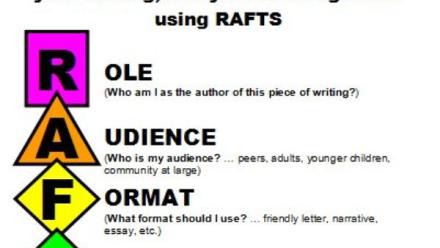Download a Graphic Organizer
RAFT is a writing strategy that helps students understand their role as a writer, the audience they will address, the varied formats for writing, and the topic they’ll be writing about.
- Role of the Writer: Who are you as the writer? A pilgrim? A soldier? The President?
- Audience: To whom are you writing? A political rally? A potential employer?
- Format: In what format are you writing? A letter? An advertisement? A speech?
- Topic: What are you writing about?
Why use the RAFT strategy?
Students must think creatively and critically in order to respond to prompts, making RAFT a unique way for students to apply critical thinking skills about new information they are learning. RAFT writing can be used across disciplines as a universal writing approach.
How to create and use the strategy
- Walk students through the acronym RAFT and why it’s important to consider various perspectives when completing any writing assignment.
- Display a RAFT writing prompt to your class and model how you would write in response to the prompt.
- Have students react to another writing prompt individually, or in small groups. It works best if all students react to the same prompt so the class can learn from each other’s responses.
- As students become comfortable in reacting to RAFT prompts, you can create more than one prompt for students to respond to after reading, a lesson, or a unit of study. Varied prompts allow students to compare and contrast multiple perspectives, deepening their understanding of the content.
Sample RAFT prompts
R: Citizen
A: Congress
F: Letter
T: Taxation
R: Scout Finch
A: Community of Monroeville, Alabama
F: Eulogy for Atticus Finch
T: Social Inequality
Strategy in action
For more RAFT prompts, review Doug Fisher and Nancy Frey’s compiled list of Picture Book RAFT prompts. You may also find a RAFT scoring rubric and additional RAFT examples helpful as you implement the RAFT strategy in your class. Now, let’s watch as a teacher uses the RAFT writing strategy in her science class.
Tips for success
- It’s important for students to learn how their writing may change for different perspectives. It’s helpful to show students examples of writings on the same topic and format but with different roles of the writer or audience.
- Once students are fluent using the RAFT strategy, they can take any topic and choose the role, audience, and format on their own.
